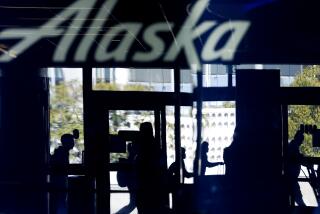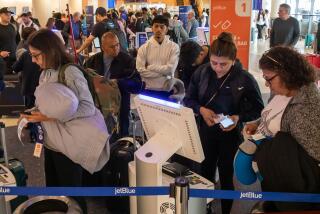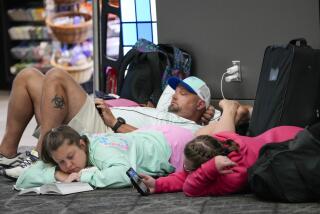Skies Getting Friendlier for Travelers--for Now
- Share via
The agony of air travel this summer is finally ending, but even airline executives warn that passengers should keep their seat belts fastened for more bumpy times ahead.
The woes that led to thousands of canceled or delayed flights this summer and infuriated consumers were blamed on bad weather, record passenger traffic, airport congestion, antiquated air-traffic-control equipment and a labor dispute between industry leader United Airlines and its 10,000 pilots.
But United, a unit of UAL Corp., and its pilots union recently agreed on a new four-year contract, and the union’s leadership is urging the pilots to ratify the deal.
Since then, United’s performance has begun improving, in good part because many of United’s pilots are again working overtime, thus precluding crew shortages.
During their contract dispute, many pilots refused overtime to protest the lack of progress in the talks, and that contributed to United’s cancellations.
In addition, AMR Corp.’s American Airlines, Continental Airlines and some other big carriers are tweaking flight schedules at their major hub airports to reduce delays and congestion that, as AMR Chairman Donald Carty put it last week, contributed to “our summer of discontent.”
AMR, for instance, is planning major adjustments at its Dallas/Fort Worth and Chicago hubs starting Oct. 1 to smooth out the peak hours when delays have been at their worst.
Finally, the weather has improved and demand for airline tickets is ebbing as it always does after the busy summer travel season. Indeed, several carriers are now following their normal habit of offering fall-travel fare discounts to keep their planes filled.
That includes United, which is promoting not only cheaper prices but also relaxing its restrictions on the lower-cost tickets as a way to gain back passengers it alienated during the summer fiasco.
“Things have gotten noticeably better,” said Kevin Mitchell, chairman of the Business Travel Coalition, an advocacy group for corporate fliers. The end of the United-pilots spat is “a major driver of the change,” he said, but credit also goes to the fact that “airline senior managements are taking the problem extremely seriously as evidenced by what American has done” with its hubs’ schedules.
Those changes show “more reality is creeping into the schedules” set by the airlines, which have been criticized for over-scheduling flights--particularly at their hubs--to stay competitive with their rivals, said James Higgins, airline analyst at Donaldson, Lufkin & Jenrette Securities.
Still, potential turbulence lies ahead. Only two months away is the Thanksgiving holiday--often the busiest time of the year for the airlines--and it remains to be seen how smoothly they will handle the renewed surge in passenger traffic that weekend.
Also, even though United is close to settling its dispute with its pilots, it’s still in contentious contract talks with its mechanics, whom the carrier earlier blamed for contributing to its summer debacle by calling in sick or refusing overtime in abnormally high numbers.
And AMR’s Carty warned that passengers can look forward to more troublesome summers before the Federal Aviation Administration fixes the “ongoing crisis in our nation’s air-traffic-control system” by installing new computers and other technology in the mid-2000s.
“The next two summers are going to be pretty ugly,” Carty said at an aviation conference last week.
Such ominous prospects were again the topic of a Senate Commerce Committee hearing later in the week, in which FAA Administrator Jane Garvey confirmed that her agency is developing capacity guidelines for the nation’s largest airports to determine how many flights each can handle safely and smoothly.
On average, U.S. airlines’ on-time performance hit a record low 66.3% in June, dragged down in large part by United’s miserable showing of 40% to 50%. The industry’s on-time figure rose to 70.3% in July, but that was still down from 71.1% in July 1999, according to Transportation Department figures.
Now, though, the situation “is going much, much better,” said United spokesman Joe Hopkins, noting that United’s on-time performance is in the 70% range and climbing. Also, cancellations at United have dropped to about 100 per day, whereas the airline was canceling about 350 of its 2,400 daily flights on some days in June and July, he said.
One reason Carty and other executives are trying to help fix the problem--besides not wanting to disenfranchise their customers--is that the airlines haven’t forgotten the scores of complaints a year ago that led to “passenger rights” legislation in Congress, said Mitchell of the Business Travel Coalition.
Yet it’s Congress that bears the burden for much of the problem, because Congress ultimately is responsible for not updating the air-traffic-control system more quickly and thus reducing congestion, said analyst Higgins.
“A lot of government officials point their fingers at the airlines because they don’t want to point them at the air-traffic-control system” and the system’s “structural problems,” he said. To do so would mean “pointing the finger back at themselves, and they don’t want to do that.”
*
Associated Press was used in compiling this report.
More to Read
Inside the business of entertainment
The Wide Shot brings you news, analysis and insights on everything from streaming wars to production — and what it all means for the future.
You may occasionally receive promotional content from the Los Angeles Times.











